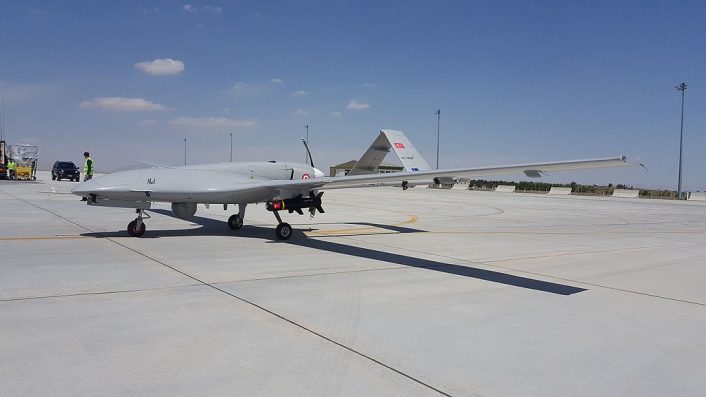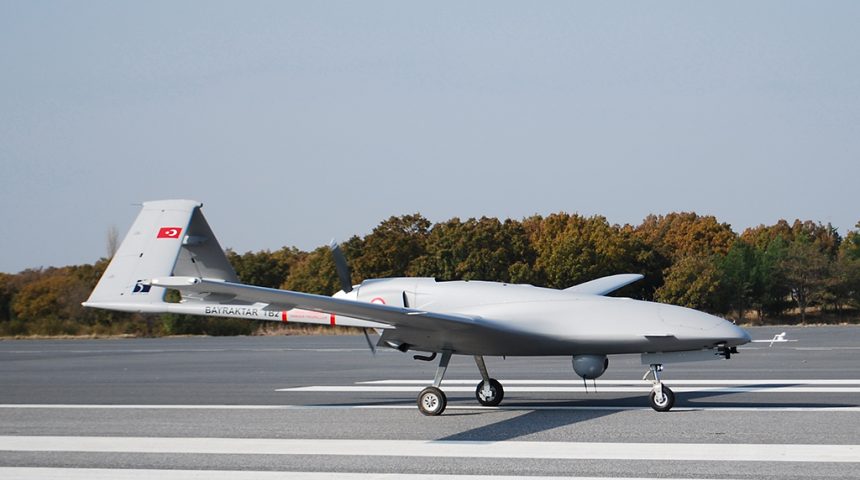Poland announced the procurement of the Turkish Bayraktar TB2 medium altitude long endurance (MALE) unmanned combat aerial vehicle (UCAV).
Polish Minister of Defence, Mariusz Błaszczak, announced that Poland will acquire the Turkish Bayraktar TB2 drones as a part of its Gryf UAV procurement program, on May 22, 2021. The first rumors emerged just last week, earlier on there was no sight of similar procurement on the roadmap. The Polish defense analysts were stunned by the news.
Już wkrótce dobre informacje… stay tuned! pic.twitter.com/UxQT0RtRjf
— Mariusz Błaszczak (@mblaszczak) May 19, 2021
It all started with a tweet, by Mariusz Błaszczak, depicting a scale model of the Turkish drone, wearing the Polish Air Force checkerboard on its side. The tweet was posted on May 19. Yesterday, on May 22, the head of the Polish MoD confirmed Poland’s willingness to acquire the drones in question, during an interview for Polskie Radio 24.
The Bayraktar TB2 medium altitude long endurance (MALE) unmanned combat aerial vehicle (UCAV) has seen combat use recently in the conflict in Nagorno Karabakh.
Poland is willing to acquire 24 UCAVs as such, armed with ATGMs. The Polish Gryf UAV acquisition program initially assumed that 15 UCAV sets would be procured (90 aircraft). It may be, that the Turkish drones are just a part of a broader procurement scheme. We do not know yet.
The Polish defense analysts criticize the procurement in a multidimensional manner, but none of the voices remain positive. Given the discourse created by the Polish MoD, suggesting that the Ministry is willing to support the Polish industry primarily, off-the-shelf acquisitions – such as the F-35 procurement (without any offset deal, and without any competitive procurement process), or the Bayraktar TB2 deal, both spark a lot of controversies.
Even though Błaszczak noted that no Polish company is manufacturing UCAVs of capabilities equivalent to these of Bayraktar, the manufacturing of such aircraft would be feasible in the Polish industry, the experts argue – both the WB Group, as well as the PGZ Group – two major Polish defense umbrella companies – could easily design and manufacture a platform as such. Michał Gajzler, from Nowa Technika Wojskowa, commented on the above as follows:
Błaszczak’s statement probably means that the Polish MoD is not willing to spend a lot on R&D – we are coming back to a problem recently signaled by Tomasz Dmitruk: the R&D expenditure in the Polish MoD is too low. This, in turn, hampers the development of the Polish industry. It is difficult to expect the private or state entities to finance their R&D autonomously, using their own funds – regardless of whether it refers to tactical long-range UAVs, or MALE UAVs. The Polish businesses cannot carry out a project as such on their own – this is proven, for instance, by statements made by the Vice-President at WB Group, who, openly, stated that the company would not be able to finance a task as such on its own. It is not the first case of the Polish MoD procuring systems off-the-shelf, leaving the technical modernization plans aside. The TB2 procurement offset agreement is to only cover the maintenance, locally, in Poland. This is not a broad agreement. The Polish MoD does not seem to be interested in a transfer of technology of any kind. This is quite the opposite thing, from what was announced before, as the MoD and the PM of Poland were claiming that unmanned platforms would become a Polish specialty. The MoD took the easy way out here. The procurement of ammunition carriers for the Rak self-propelled mortar units announced on the same day, could be viewed as a fig leaf.
Other concerns refer specifically to the operational environment in which the Bayraktar TB2s have been and potentially will be operating.
The Polish defense and security analysts doubt whether a lack of systemic approach, seen in the procurement discussed within the present article, would bring any benefits other than the rapid acquisition of a system that would ultimately be a standalone, non-networked solution.
Michał Piekarski, Ph.D., a defense analyst, and security researcher from Poland (University of Wrocław) told us about his concerns, regarding the acquisition:
The decision is quite surprising, especially given the availability of the local industrial resources. Not only is the matter related to manufacturing alone, as local, domestic entities have been delivering UAVs already integrated within the Polish C2 network – this refers to the WB Group’s FlyEye platform primarily. In fact, the Polish artillery component is operating the FlyEye, as they are simply a part of the system. If Poland receives the Bayraktar TB2s, regardless of the politics, the platform may be isolated from the remaining components used in the multi-domain environment. The role of the aforesaid drones is another matter. 4 packages is the quantity, which means that 1 package would be assigned to each land forces’ division. It still remains unclear, however, how these drones would fare against the Russian IADS. The procurement announced out of the blue also begs another question: was it based on an in-depth analysis or made, because last year UCAVs became fashionable, following the tensions in Nagorno Karabakh?
Another dimension of the acquisition is related to the PR surrounding the Turkish drones, and the successful employment in operational conditions. The potential employment in the Armed Conflict on the NATO eastern flank might be much different than a limited scale warfare. Dawid Kamizela, Polish defense journalist (Nowa Technika Wojskowa, Frag Out!), expressed his doubts, being similar to the ones voiced by Piekarski, as follows:
The success of these UAVs, or tactical armed UCAV platforms in general, is dependent on the environment in which they are operated. In case of the famour US Predator and Reaper UAVs, they were usually used in an environment where virtually no enemy air defense systems were present. In case of the Turkish drones, these have been used on battlefields where VSHORAD (Very Short Range Air Defense Systems) assets were present – such as the Russian Pantsir solution. So how come, that the drones had a successful PR, being depicted as a platform capable of acting agaist assets protected by VSHORAD systems? The answer is buried in the systemic approach, as Bayraktar TB2s have been a part on an effective system tha also included ELINT assets and armament – such as tube and rocket artillery. The Pantsir systems on the other side had no systemic foundation at hand. They were used as individual assets, without early warning radars electronic warfare assets, or an efficient C2 solution – and it is difficult to claim that the Russian military does not have these assets at hand. Meanwhile, the challenge posed by the integration of the Turkish UCAVs with the Polish C2 assets (such as the WB Group’s TOPAZ system), is another point that is difficult to be discussed – it is an obvious doubt and unknown area.
Considering the global trend to integrate all domains on the battlefield, into a single, coherent battlespace, troubles in the integration of a new system into the national, coherent network, seem to be quite concerning. The general discourse, regarding the development of modern military operations, raises an argument of a multi-domain concept of operations. As no statements were made about the integration of the Turkish Bayraktar TB2 platforms in Poland’s C4ISR network, this is undoubtedly a point to be aware of.

Turkey is also expanding its involvement on the NATO Eastern Flank: recently its E-7 AWACS platform was deployed to Romania; yesterday the head of the Polish MoD also announced that the Turkish F-16 jets would be deployed to the Polish Malbork AB, to support NATO’s Baltic Air Policing operation.









